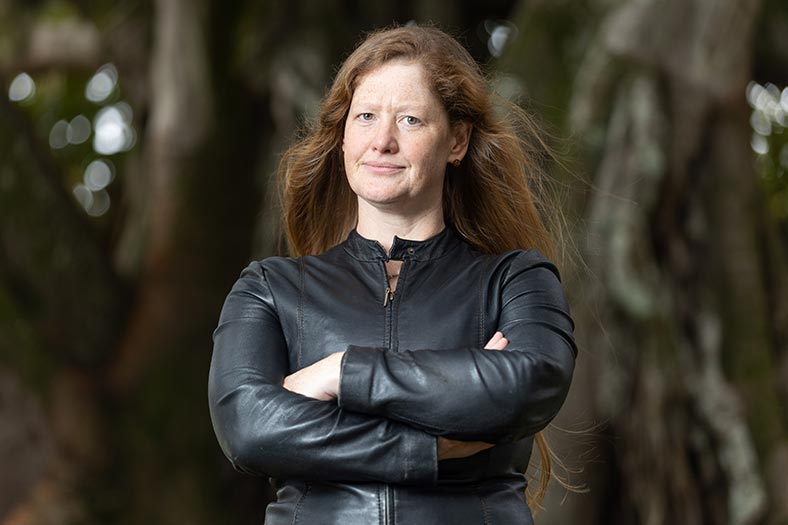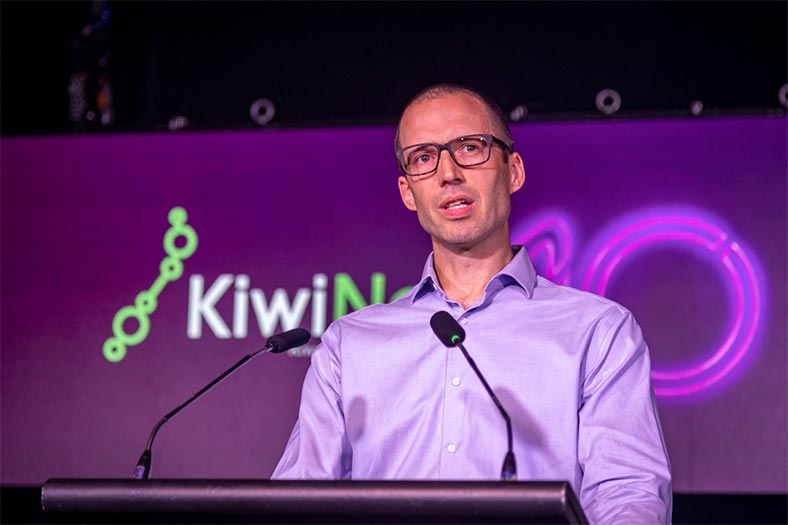Co-Directors appointed Fellows of the Royal Society of New Zealand Te Apārangi
4 April, 2024
MacDiarmid Institute Co-Directors Professor Nicola Gaston and Professor Justin Hodgkiss have both been elected to the New Zealand Royal Society Te Apārangi's Academy.
Welcoming the announcement, MacDiarmid Institute Board Chair Hēmi Rolleston (Ngāti Whakaue, Ngāi Te Rangi, Ngāti Ranginui) congratulated both Institute Co-Directors, noting that election to the FRSNZ was an extremely high honour.
"Professor Gaston and Professor Hodgkiss are each world leaders in their respective areas of research and scholarship, and on behalf of the Institute, I congratulate them both for their achievement."
Mr Rolleston said that the two Co-Directors were following in illustrious footsteps, observing that the Institute's founder, Sir Paul Callaghan, as well as the Institute's namesake, Nobel Laureate Professor Alan MacDiarmid, were each a Fellow and Honorary Fellow respectively of the Royal Society Te Apārangi.
"For us this honour is all the more special because Professor Gaston and Professor Hodgkiss follow in the path of both our founder Sir Paul Callaghan and our namesake Alan MacDiarmid."
He said that Sir Paul Callaghan was elected as a Fellow of the Royal Society Te Apārangi in 1990 and that Professor MacDiarmid became an Honorary Fellow in 2001. (Since its earliest days Royal Society Te Apārangi has made provision for the election of Honorary Fellows from overseas institutions).
Mr Rolleston said he was also pleased to see that the Royal Society Te Apārangi had noted that the research of both Co-Directors aligned strongly with the sustainability focussed materials science research of the Institute.
"Both Professor Gaston's research using advanced computational simulations to study materials, and Professor Hodgkiss' discoveries of design rules for more effective solar photovoltaic materials, directly support the Institute's research programmes of Zero Carbon, Zero Waste, Low Energy Tech and Sustainable Resource Use. These research areas are critical to a sustainable future for our planet."
"This is not only an achievement for the Co-Directors, but for the Institute as well. Your success," he told them, "is the Institute's success."
He said that developing and owning the IP to critical sustainable tech discoveries here in Aotearoa New Zealand would be key to growing the wealth of this country, noting that Professor Hodgkiss himself had spun out a start-up company.
"The Institute's researchers have spun out 30 start-up companies, mostly into the Deep Tech arena, and our graduates go on to work in many of the companies that drive this economically valuable sector."
Professor Gaston and Professor Hodgkiss are each world leaders in their respective areas of research and scholarship
Hēmi Rolleston MacDiarmid Institute Board Chair
The Royal Society has 22 new Ngā Ahurei a Te Apārangi Fellows and Ngā Ahurei Honore a Te Apārangi Honorary Fellows this year. The new Fellows have been elected to the Academy of the Royal Society Te Apārangi for their distinction in research and advancement of science, technology or the humanities. Being made a Fellow is an honour that recognises distinction in research, scholarship or the advancement of knowledge at the highest international standards. Fellows can use the post-nominal 'FRSNZ' after their name to indicate this honour.
Professor Gaston and Professor Hodgkiss join the more than 400 Fellows (FRSNZ) who have been elected to the New Zealand Royal Society Te Apārangi's Academy since 1919 for distinction in research or for advancing science, technology and the humanities.
Professor Nicola Gaston, University of Auckland
 Elected for her important insight into the behaviour of low-temperature, liquid metals.
Elected for her important insight into the behaviour of low-temperature, liquid metals.
'Nicola Gaston is an eminent theoretical physicist who studies materials through advanced computational simulations. Her calculations solve the equations that describe the quantum mechanical structure of the atoms in unconventional materials, and predict the properties that depend upon the detailed arrangement of those atoms in space.
'Nicola's research is internationally recognised for providing particularly important insight into the behaviour of low-temperature, liquid metals. Her findings have enabled others to use these materials in a range of important technological applications. She also co-directs the MacDiarmid Institute for Advanced Materials and Nanotechnology in New Zealand, leading it to achieve its vision of fostering and supporting world-class materials research that addresses the key sustainability challenges of our times.'
(From Royal Society of New Zealand Te Apārangi)
Professor Justin Hodgkiss, Te Herenga Waka - Victoria University of Wellington
 Elected for the development of ultrafast optical spectroscopy tools that provide unique insights into biomaterials and next generation solar cells.
Elected for the development of ultrafast optical spectroscopy tools that provide unique insights into biomaterials and next generation solar cells.
'Justin Hodgkiss has developed ultrafast optical tools that reveal how different materials, from skin to solar cells, respond to light. Justin and his team team discovered how the brown pigment, eumelanin, offers protection from UV light, resolving an elusive problem in photobiology, and suggesting approaches for bio-based sunscreens. In the case of solar photovoltaic cells, Justin's work has resolved the key light-to-current conversion processes on the femtosecond (one millionth of a billionth of a second) timescale.
'In understanding the light response of candidate photovoltaic materials, Justin's team has discovered design rules for more effective solar photovoltaic materials. These design rules are embodied in a new class of organic solar cell materials, which now display record efficiencies and are nearing commercial viability. Justin and his team have now commercialised an ultrafast spectrometer they invented, selling instruments worldwide. Justin is also Co-director of the MacDiarmid Institute that seeks to support sustainability through such discoveries.'
(From Royal Society of New Zealand Te Apārangi)


